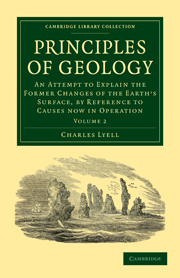 Principles of Geology
Principles of Geology Summary
In continuing our investigation of the manner in which the animal and vegetable creation leave permanent marks of their existence on the emerged lands, we have next to examine,
The imbedding of organic remains in alluvium, and the ruins caused by landslips.
We restrict the term alluvium to such transported matter as has been thrown down, whether by rivers, floods, or other causes, upon land not permanently submerged beneath the waters of lakes or seas.
The alluvium of the bed of a river does not often contain any animal or vegetable remains, for the whole mass is so continually shifting its place, and the attrition of the various parts is so great, that even the hardest rocks contained in it are, at length, ground down to powder. But when sand, mud, and rubbish, are suddenly swept by a flood, and then let fall upon the land, such an alluvium may envelop trees or the remains of animals, which may, in this manner, be permanently preserved.
The sudden descent of a body of water which had been discharged by a small artificial drain from a lake in Vermont, in the United States, in 1810, covered a wide valley with the spoils of the land washed down from the higher country.
- Type
- Chapter
- Information
- Principles of GeologyAn Attempt to Explain the Former Changes of the Earth's Surface, by Reference to Causes now in Operation, pp. 228 - 238Publisher: Cambridge University PressPrint publication year: 2009First published in: 1832


